Software Engineering Overview
Let us first understand what software engineering stands for. The term is made of two words, software and engineering.
Software is more than just a program code. A program is an executable code, which serves some computational purpose. Software is considered to be collection of executable programming code, associated libraries and documentations. Software, when made for a specific requirement is called software product.
Engineering on the other hand, is all about developing products, using well-defined, scientific principles and methods.

Software engineering is an engineering branch associated with development of software product using well-defined scientific principles, methods and procedures. The outcome of software engineering is an efficient and reliable software product.
Definitions
IEEE defines software engineering as:
(1) The application of a systematic,disciplined,quantifiable approach to the development,operation and maintenance of software; that is, the application of engineering to software.
(2) The study of approaches as in the above statement.
Fritz Bauer, a German computer scientist, defines software engineering as:
Software engineering is the establishment and use of sound engineering principles in order to obtain economically software that is reliable and work efficiently on real machines.
Software Evolution
The process of developing a software product using software engineering principles and methods is referred to as software evolution. This includes the initial development of software and its maintenance and updates, till desired software product is developed, which satisfies the expected requirements.
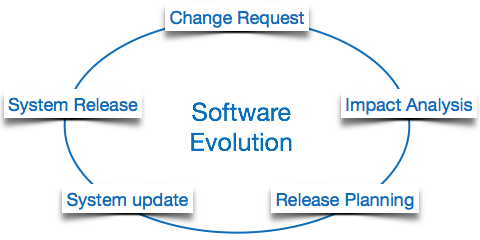
Evolution starts from the requirement gathering process. After which developers create a prototype of the intended software and show it to the users to get their feedback at the early stage of software product development. The users suggest changes, on which several consecutive updates and maintenance keep on changing too. This process changes to the original software, till the desired software is accomplished.
Even after the user has desired software in hand, the advancing technology and the changing requirements force the software product to change accordingly. Re-creating software from scratch and to go one-on-one with requirement is not feasible. The only feasible and economical solution is to update the existing software so that it matches the latest requirements.
Software Evolution Laws
Lehman has given laws for software evolution. He divided the software into three different categories:
S-type (static-type) - This is a software, which works strictly according to defined specifications and solutions. The solution and the method to achieve it, both are immediately understood before coding. The s-type software is least subjected to changes hence this is the simplest of all. For example, calculator program for mathematical computation.P-type (practical-type) - This is a software with a collection of procedures. This is defined by exactly what procedures can do. In this software, the specifications can be described but the solution is not obvious instantly. For example, gaming software.E-type (embedded-type) - This software works closely as the requirement of real-world environment. This software has a high degree of evolution as there are various changes in laws, taxes etc. in the real world situations. For example, Online trading software.
E-Type software evolution
Lehman has given eight laws for E-Type software evolution -
Continuing change - An E-type software system must continue to adapt to the real world changes, else it becomes progressively less useful.Increasing complexity - As an E-type software system evolves, its complexity tends to increase unless work is done to maintain or reduce it.Conservation of familiarity - The familiarity with the software or the knowledge about how it was developed, why was it developed in that particular manner etc. must be retained at any cost, to implement the changes in the system.Continuing growth- In order for an E-type system intended to resolve some business problem, its size of implementing the changes grows according to the lifestyle changes of the business.Reducing quality - An E-type software system declines in quality unless rigorously maintained and adapted to a changing operational environment.Feedback systems- The E-type software systems constitute multi-loop, multi-level feedback systems and must be treated as such to be successfully modified or improved.Self-regulation - E-type system evolution processes are self-regulating with the distribution of product and process measures close to normal.Organizational stability - The average effective global activity rate in an evolving E-type system is invariant over the lifetime of the product.
Software Paradigms
Software paradigms refer to the methods and steps, which are taken while designing the software. There are many methods proposed and are in work today, but we need to see where in the software engineering these paradigms stand. These can be combined into various categories, though each of them is contained in one another:
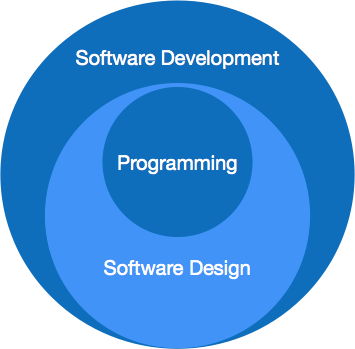
Programming paradigm is a subset of Software design paradigm which is further a subset of Software development paradigm.
Software Development Paradigm
This Paradigm is known as software engineering paradigms where all the engineering concepts pertaining to the development of software are applied. It includes various researches and requirement gathering which helps the software product to build. It consists of –
Requirement gatheringSoftware designProgramming
Software Design Paradigm
This paradigm is a part of Software Development and includes –
DesignMaintenanceProgramming
Programming Paradigm
This paradigm is related closely to programming aspect of software development. This includes –
CodingTestingIntegration
Need of Software Engineering
The need of software engineering arises because of higher rate of change in user requirements and environment on which the software is working.
Large software - It is easier to build a wall than to a house or building, likewise, as the size of software become large engineering has to step to give it a scientific process.Scalability- If the software process were not based on scientific and engineering concepts, it would be easier to re-create new software than to scale an existing one.Cost- As hardware industry has shown its skills and huge manufacturing has lower down he price of computer and electronic hardware. But the cost of software remains high if proper process is not adapted.Dynamic Nature- The always growing and adapting nature of software hugely depends upon the environment in which user works. If the nature of software is always changing, new enhancements need to be done in the existing one. This is where software engineering plays a good role.Quality Management- Better process of software development provides better and quality software product.
Characteristics of good software
A software product can be judged by what it offers and how well it can be used. This software must satisfy on the following grounds:
OperationalTransitionalMaintenance
Well-engineered and crafted software is expected to have the following characteristics:
Operational
This tells us how well software works in operations. It can be measured on:
BudgetUsabilityEfficiencyCorrectnessFunctionalityDependabilitySecuritySafety
Transitional
This aspect is important when the software is moved from one platform to another:
PortabilityInteroperabilityReusabilityAdaptability
Maintenance
This aspect briefs about how well a software has the capabilities to maintain itself in the ever-changing environment:
ModularityMaintainabilityFlexibilityScalability
In short, Software engineering is a branch of computer science, which uses well-defined engineering concepts required to produce efficient, durable, scalable, in-budget and on-time software products.
Software Development Life Cycle
Software Development Life Cycle, SDLC for short, is a well-defined, structured sequence of stages in software engineering to develop the intended software product.
SDLC Activities
SDLC provides a series of steps to be followed to design and develop a software product efficiently. SDLC framework includes the following steps:

Communication
This is the first step where the user initiates the request for a desired software product. He contacts the service provider and tries to negotiate the terms. He submits his request to the service providing organization in writing.
Requirement Gathering
This step onwards the software development team works to carry on the project. The team holds discussions with various stakeholders from problem domain and tries to bring out as much information as possible on their requirements. The requirements are contemplated and segregated into user requirements, system requirements and functional requirements. The requirements are collected using a number of practices as given -
studying the existing or obsolete system and software,conducting interviews of users and developers,referring to the database orcollecting answers from the questionnaires.
Feasibility Study
After requirement gathering, the team comes up with a rough plan of software process. At this step the team analyzes if a software can be made to fulfill all requirements of the user and if there is any possibility of software being no more useful. It is found out, if the project is financially, practically and technologically feasible for the organization to take up. There are many algorithms available, which help the developers to conclude the feasibility of a software project.
System Analysis
At this step the developers decide a roadmap of their plan and try to bring up the best software model suitable for the project. System analysis includes Understanding of software product limitations, learning system related problems or changes to be done in existing systems beforehand, identifying and addressing the impact of project on organization and personnel etc. The project team analyzes the scope of the project and plans the schedule and resources accordingly.
Software Design
Next step is to bring down whole knowledge of requirements and analysis on the desk and design the software product. The inputs from users and information gathered in requirement gathering phase are the inputs of this step. The output of this step comes in the form of two designs; logical design and physical design. Engineers produce meta-data and data dictionaries, logical diagrams, data-flow diagrams and in some cases pseudo codes.
Coding
This step is also known as programming phase. The implementation of software design starts in terms of writing program code in the suitable programming language and developing error-free executable programs efficiently.
Testing
An estimate says that 50% of whole software development process should be tested. Errors may ruin the software from critical level to its own removal. Software testing is done while coding by the developers and thorough testing is conducted by testing experts at various levels of code such as module testing, program testing, product testing, in-house testing and testing the product at user’s end. Early discovery of errors and their remedy is the key to reliable software.
Integration
Software may need to be integrated with the libraries, databases and other program(s). This stage of SDLC is involved in the integration of software with outer world entities.
Implementation
This means installing the software on user machines. At times, software needs post-installation configurations at user end. Software is tested for portability and adaptability and integration related issues are solved during implementation.
Operation and Maintenance
This phase confirms the software operation in terms of more efficiency and less errors. If required, the users are trained on, or aided with the documentation on how to operate the software and how to keep the software operational. The software is maintained timely by updating the code according to the changes taking place in user end environment or technology. This phase may face challenges from hidden bugs and real-world unidentified problems.
Disposition
As time elapses, the software may decline on the performance front. It may go completely obsolete or may need intense upgradation. Hence a pressing need to eliminate a major portion of the system arises. This phase includes archiving data and required software components, closing down the system, planning disposition activity and terminating system at appropriate end-of-system time.
Software Development Paradigm
The software development paradigm helps developer to select a strategy to develop the software. A software development paradigm has its own set of tools, methods and procedures, which are expressed clearly and defines software development life cycle. A few of software development paradigms or process models are defined as follows:
Waterfall Model
Waterfall model is the simplest model of software development paradigm. It says the all the phases of SDLC will function one after another in linear manner. That is, when the first phase is finished then only the second phase will start and so on.
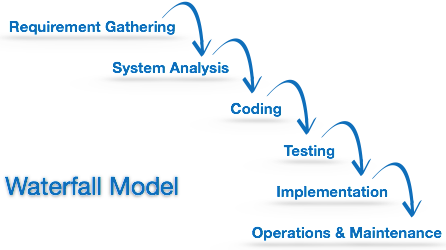
This model assumes that everything is carried out and taken place perfectly as planned in the previous stage and there is no need to think about the past issues that may arise in the next phase. This model does not work smoothly if there are some issues left at the previous step. The sequential nature of model does not allow us go back and undo or redo our actions.
This model is best suited when developers already have designed and developed similar software in the past and are aware of all its domains.
Iterative Model
This model leads the software development process in iterations. It projects the process of development in cyclic manner repeating every step after every cycle of SDLC process.
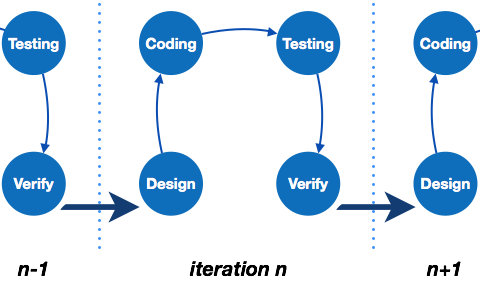
The software is first developed on very small scale and all the steps are followed which are taken into consideration. Then, on every next iteration, more features and modules are designed, coded, tested and added to the software. Every cycle produces a software, which is complete in itself and has more features and capabilities than that of the previous one.
After each iteration, the management team can do work on risk management and prepare for the next iteration. Because a cycle includes small portion of whole software process, it is easier to manage the development process but it consumes more resources.
Spiral Model
Spiral model is a combination of both, iterative model and one of the SDLC model. It can be seen as if you choose one SDLC model and combine it with cyclic process (iterative model).
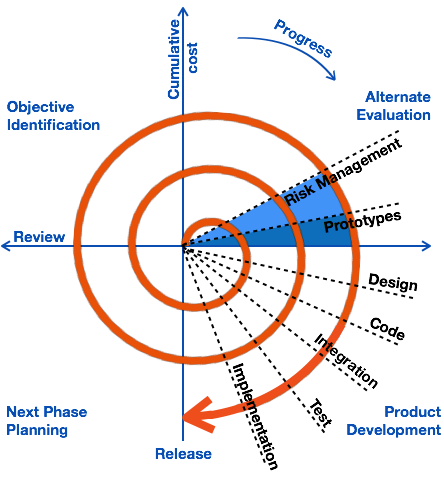
This model considers risk, which often goes un-noticed by most other models. The model starts with determining objectives and constraints of the software at the start of one iteration. Next phase is of prototyping the software. This includes risk analysis. Then one standard SDLC model is used to build the software. In the fourth phase of the plan of next iteration is prepared.
V – model
The major drawback of waterfall model is we move to the next stage only when the previous one is finished and there was no chance to go back if something is found wrong in later stages. V-Model provides means of testing of software at each stage in reverse manner.

At every stage, test plans and test cases are created to verify and validate the product according to the requirement of that stage. For example, in requirement gathering stage the test team prepares all the test cases in correspondence to the requirements. Later, when the product is developed and is ready for testing, test cases of this stage verify the software against its validity towards requirements at this stage.
This makes both verification and validation go in parallel. This model is also known as verification and validation model.
Big Bang Model
This model is the simplest model in its form. It requires little planning, lots of programming and lots of funds. This model is conceptualized around the big bang of universe. As scientists say that after big bang lots of galaxies, planets and stars evolved just as an event. Likewise, if we put together lots of programming and funds, you may achieve the best software product.
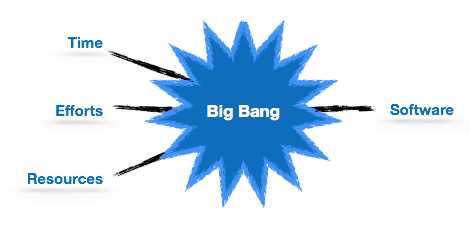
For this model, very small amount of planning is required. It does not follow any process, or at times the customer is not sure about the requirements and future needs. So the input requirements are arbitrary.
This model is not suitable for large software projects but good one for learning and experimenting.
For an in-depth reading on SDLC and its various models, click here.
Software Project Management
The job pattern of an IT company engaged in software development can be seen split in two parts:
Software CreationSoftware Project Management
A project is well-defined task, which is a collection of several operations done in order to achieve a goal (for example, software development and delivery). A Project can be characterized as:
Every project may has a unique and distinct goal.Project is not routine activity or day-to-day operations.Project comes with a start time and end time.Project ends when its goal is achieved hence it is a temporary phase in the lifetime of an organization.Project needs adequate resources in terms of time, manpower, finance, material and knowledge-bank.
Software Project
A Software Project is the complete procedure of software development from requirement gathering to testing and maintenance, carried out according to the execution methodologies, in a specified period of time to achieve intended software product.
Need of software project management
Software is said to be an intangible product. Software development is a kind of all new stream in world business and there’s very little experience in building software products. Most software products are tailor made to fit client’s requirements. The most important is that the underlying technology changes and advances so frequently and rapidly that experience of one product may not be applied to the other one. All such business and environmental constraints bring risk in software development hence it is essential to manage software projects efficiently.

The image above shows triple constraints for software projects. It is an essential part of software organization to deliver quality product, keeping the cost within client’s budget constrain and deliver the project as per scheduled. There ar
No comments:
Post a Comment